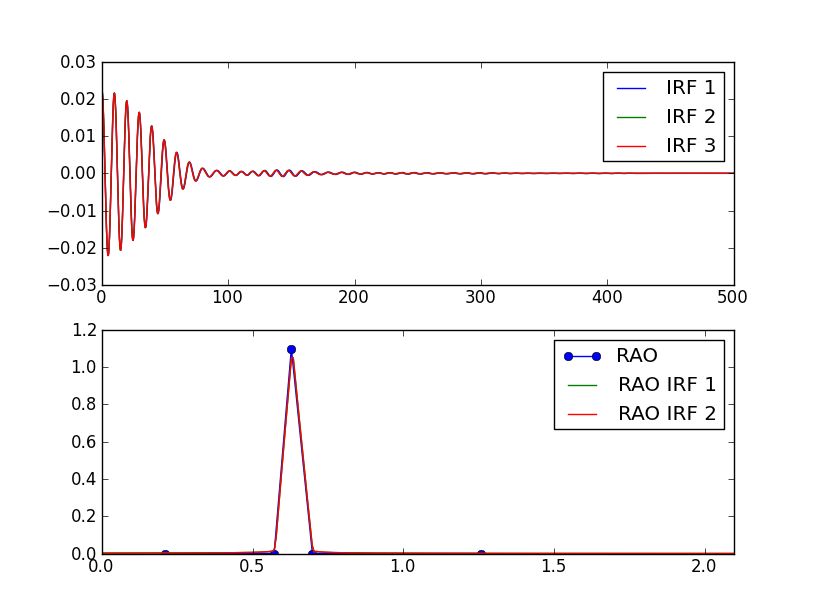I think I must have misunderstood something regarding the relation between impulse and frequency responses.
I have calculated the Impulse Response Function, IRF, from the Frequency Response Function, FRF, by FFT and then I find some strange things, among these that my assumption that the IRF will always be real is not correct. I have in my code used only the real part of the result from FFT when defining the IRF. Then the amplitude response (and phase) are not correct when I convolve my signal with a sine wave. I expect no phase lag and a slight amplification of a sine wave with period 10 seconds, but get a signal with the wrong amplitude and a slight phase mismatch instead.
What should I do with the imaginary part of the IRF i get back from FFT?
Details for those with a lot of time:
I am using Python and NumPy to try to work out the response of a LTI system to an arbitrary response. I guess the same would apply to Matlab or any other numerical tool implementing DFT. I know a priori the frequency response function, FTR (called a Response Amplitude Operator, RAO, in my field, naval hydrodynamics). As a test case I define my FRF as follows:
# Define RAO
omegas = 2*pi / numpy.array([5, 9, 10, 11, 30])
rao = numpy.array([0, 0, 1.1, 0, 0], dtype=complex) # Fake "ship roll" RAO
The frequency response for my fake ship roll RAO is 1.1 for a wave period of 10 seconds and zero when you get more than one second in wave period away from the peak.
I am using numpy.fft to find the impulse response function, IRF. I interpolate my RAO and apply FFT:
def make_double(x):
"""
Make a double spectrum by copying the input reversed
Does not divide the results by two after the mirroring
"""
return numpy.concatenate((x, x[::-1]))
def rao_to_irf(omegas, rao, tmax, dt):
"""
Take an RAO defined for a set of (increasing) frequencies and
compute the corresponding impulse response function by FFT.
The RAO is inter-/extrapolated to the necessary delta omega
required to obtain the wanted time step, delta t
The RAO is assumed to be a complex array
"""
assert omegas[0] < omegas[-1], "The RAO frequencies, omegas, must be given in increasing order"
N = numpy.ceil(tmax/dt)
dw = pi/N/dt
omegas_long = numpy.arange(N, dtype=float)*dw
rao_long = interpolate_complex_1d(omegas, rao, fill=0)(omegas_long)
irf = ifft(make_double(rao_long))[:N]*N/tmax
t = numpy.arange(N)*dt
return t, irf.real
Now I have an IRF (?). To check the response I also implemented the inverse and see that the RAO/FRF calculated from the IRF looks similar to the input RAO (when interpolated to constant frequency spacing).
I can now combine my RAO/FRF with a wave spectrum and perform a time realization using FFT. I also make a realization of the spectrum to get the unmodified input wave signal. This signal I convolve with the IRF.
I get the expected result if my RAO/FRF is 1 for all frequencies (meaning I get the wave signal back). However the response to the peaked RAO defined above is not as I expect. The time realization from the wave spectrum multiplied by the RAO^2 is not the same as the result of the convolution. Should not these match. I am pretty sure our code to make realizations of response spectra works as it should and I have tested with wave spectra consisting of one pure sine wave and the response is as expected with an FFT of the response spectrum, but not when using convolution


Sorry for the convoluted question
